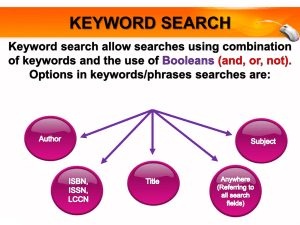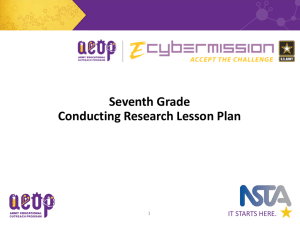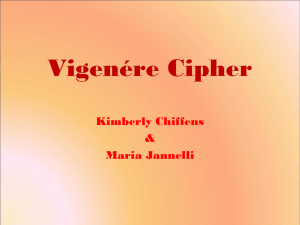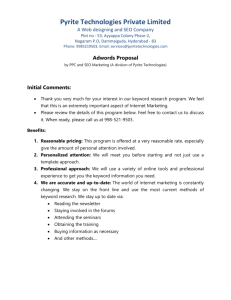Chapter 4 practice test Key
advertisement
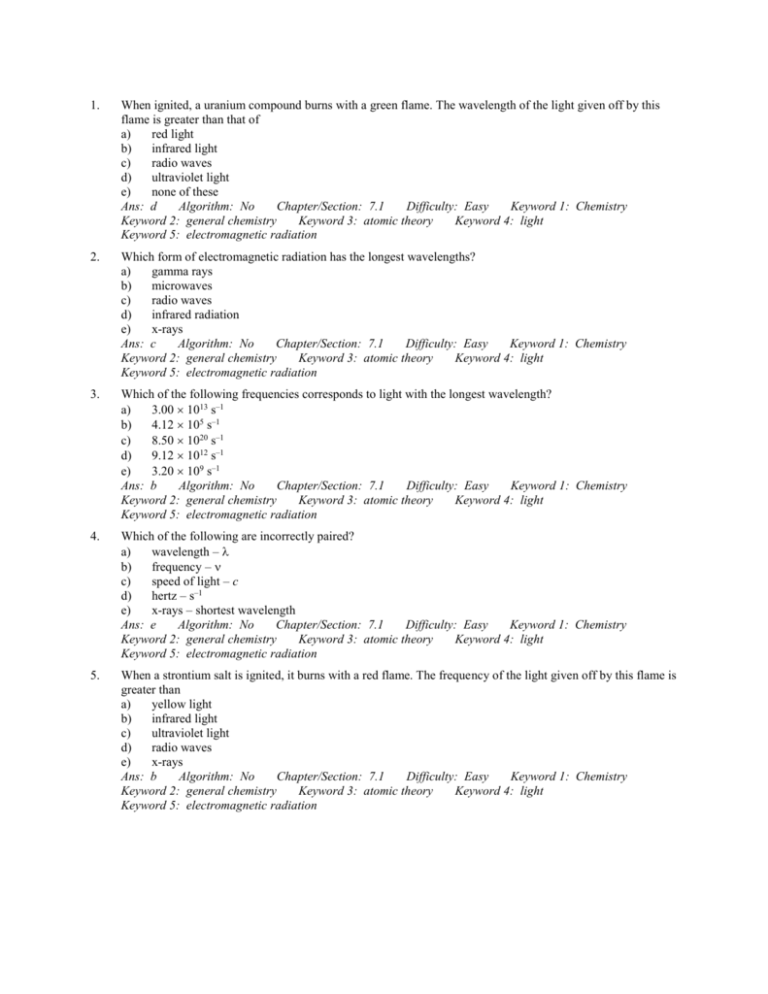
1. When ignited, a uranium compound burns with a green flame. The wavelength of the light given off by this flame is greater than that of a) red light b) infrared light c) radio waves d) ultraviolet light e) none of these Ans: d Algorithm: No Chapter/Section: 7.1 Difficulty: Easy Keyword 1: Chemistry Keyword 2: general chemistry Keyword 3: atomic theory Keyword 4: light Keyword 5: electromagnetic radiation 2. Which form of electromagnetic radiation has the longest wavelengths? a) gamma rays b) microwaves c) radio waves d) infrared radiation e) x-rays Ans: c Algorithm: No Chapter/Section: 7.1 Difficulty: Easy Keyword 1: Chemistry Keyword 2: general chemistry Keyword 3: atomic theory Keyword 4: light Keyword 5: electromagnetic radiation 3. Which of the following frequencies corresponds to light with the longest wavelength? a) 3.00 1013 s–1 b) 4.12 105 s–1 c) 8.50 1020 s–1 d) 9.12 1012 s–1 e) 3.20 109 s–1 Ans: b Algorithm: No Chapter/Section: 7.1 Difficulty: Easy Keyword 1: Chemistry Keyword 2: general chemistry Keyword 3: atomic theory Keyword 4: light Keyword 5: electromagnetic radiation 4. Which of the following are incorrectly paired? a) wavelength – b) frequency – c) speed of light – c d) hertz – s–1 e) x-rays – shortest wavelength Ans: e Algorithm: No Chapter/Section: 7.1 Difficulty: Easy Keyword 1: Chemistry Keyword 2: general chemistry Keyword 3: atomic theory Keyword 4: light Keyword 5: electromagnetic radiation 5. When a strontium salt is ignited, it burns with a red flame. The frequency of the light given off by this flame is greater than a) yellow light b) infrared light c) ultraviolet light d) radio waves e) x-rays Ans: b Algorithm: No Chapter/Section: 7.1 Difficulty: Easy Keyword 1: Chemistry Keyword 2: general chemistry Keyword 3: atomic theory Keyword 4: light Keyword 5: electromagnetic radiation 6. A line in the spectrum of atomic mercury has a wavelength of 258 nm. When mercury emits a photon of light at this wavelength, the frequency of this light is a) 8.61 10–16 s–1 b) 7.70 10–19 s–1 c) 1.16 1015 s–1 d) 77.3 s–1 e) none of these Ans: c Algorithm: Yes Chapter/Section: 7.1 Difficulty: Easy Keyword 1: Chemistry Keyword 2: general chemistry Keyword 3: atomic theory Keyword 4: light Keyword 5: electromagnetic radiation 7. What is the wavelength of a photon of red light (in nm) whose frequency is 4.64 1014 Hz? a) 646 nm b) 1.55 106 nm c) 155 nm d) 464 nm e) none of these Ans: a Algorithm: Yes Chapter/Section: 7.1 Difficulty: Easy Keyword 1: Chemistry Keyword 2: general chemistry Keyword 3: atomic theory Keyword 4: light Keyword 5: electromagnetic radiation 8. T F The SI unit for frequency is cycles per second. Ans: False Algorithm: No Chapter/Section: 7.1 Difficulty: Easy Keyword 1: Chemistry Keyword 2: general chemistry Keyword 3: atomic theory Keyword 4: light Keyword 5: electromagnetic radiation 9. Green light can have a wavelength of 512 nm. The energy of a photon of this light is a) 1.02 10–31 J b) 5.12 10–7 J c) 3.88 10–19 J d) 5.86 1014 J e) 2.58 1018 J Ans: c Algorithm: Yes Chapter/Section: 7.2 Difficulty: Easy Keyword 1: Chemistry Keyword 2: general chemistry Keyword 3: atomic theory Keyword 4: light Keyword 5: electromagnetic radiation 10. Consider an atom traveling at 1% of the speed of light. The de Broglie wavelength is found to be 3.32 10–3 pm. Which element is this? a) He b) Ca c) Hg d) Be e) P Ans: b Algorithm: Yes Chapter/Section: 7.2 Difficulty: Moderate Keyword 1: Chemistry Keyword 2: general chemistry Keyword 3: atomic theory Keyword 4: quantum mechanics Keyword 5: de Broglie relation 11. Which one of the following types of radiation has the shortest wavelength, the greatest energy, and the highest frequency? a) Ultraviolet radiation. b) Infrared radiation. c) Visible red light. d) Visible blue light. e) None, because short wavelength is associated with low energy and low frequency, not high energy and high frequency. Ans: a Algorithm: No Chapter/Section: 7.2 Difficulty: Easy Keyword 1: Chemistry Keyword 2: general chemistry Keyword 3: atomic theory Keyword 4: light Keyword 5: electromagnetic radiation 12. What is the energy of a photon of violet light that has a wavelength of 425 nm? a) 4.25 10–7 J b) 4.67 10–19 J c) 7.05 1014 J d) 8.44 10–32 J e) 2.14 1018 J Ans: b Algorithm: Yes Chapter/Section: 7.2 Difficulty: Easy Keyword 1: Chemistry Keyword 2: general chemistry Keyword 3: atomic theory Keyword 4: light Keyword 5: electromagnetic radiation 13. How many of the following is/are incorrect? i. The importance of the equation E = mc2 is that energy has mass. ii. Electromagnetic radiation can be thought of as a stream of particles called photons. iii. Electromagnetic radiation exhibits wave properties. iv. Energy can only occur in discrete units called quanta. a) 0 b) 1 c) 2 d) 3 e) 4 Ans: a Algorithm: No Chapter/Section: 7.2 Difficulty: Easy Keyword 1: Chemistry Keyword 2: general chemistry Keyword 3: atomic theory Keyword 4: light Keyword 5: electromagnetic radiation Use the following to answer questions 14-17: From the following list of observations, choose the one that most clearly supports the following conclusion: a) emission spectrum of hydrogen b) the photoelectric effect c) scattering of alpha particles by metal foil d) diffraction e) cathode "rays" 14. Electrons have wave properties. a) observation a b) observation b c) observation c d) observation d e) observation e Ans: d Algorithm: No Chapter/Section: 7.2 Difficulty: Easy Keyword 1: Chemistry Keyword 2: general chemistry Keyword 3: atomic theory Keyword 4: quantum mechanics 15. Electromagnetic radiation has wave characteristics. a) observation a b) observation b c) observation c d) observation d e) observation e Ans: d Algorithm: No Chapter/Section: 7.2 Difficulty: Easy Keyword 1: Chemistry Keyword 2: general chemistry Keyword 3: atomic theory Keyword 4: light Keyword 5: electromagnetic radiation 16. Electrons in atoms have quantized energies. a) observation a b) observation b c) observation c d) observation d e) observation e Ans: a Algorithm: No Chapter/Section: 7.3 Difficulty: Easy Keyword 1: Chemistry Keyword 2: general chemistry Keyword 3: atomic theory Keyword 4: quantum mechanics Keyword 5: quantum effects and photons 17. Spacing between atoms in a crystal is on the same order as the de Broglie wavelength of accelerated electrons. a) observation a b) observation b c) observation c d) observation d e) observation e Ans: d Algorithm: No Chapter/Section: 7.2 Difficulty: Easy Keyword 1: Chemistry Keyword 2: general chemistry Keyword 3: atomic theory Keyword 4: quantum mechanics Keyword 5: de Broglie relation 18. T F Diffraction results when light is scattered from a regular array of points or lines. Ans: True Algorithm: No Chapter/Section: 7.2 Difficulty: Easy Keyword 1: Chemistry Keyword 2: general chemistry Keyword 3: atomic theory Keyword 4: light 19. T F All matter exhibits either particulate or wave properties exclusively. Ans: False Algorithm: No Chapter/Section: 7.2 Difficulty: Easy Keyword 1: Chemistry Keyword 2: general chemistry Keyword 3: atomic theory Keyword 4: light 20. The four lines observed in the visible emission spectrum of hydrogen tell us that: a) The hydrogen molecules they came from have the formula H4. b) We could observe more lines if we had a stronger prism. c) There are four electrons in an excited hydrogen atom. d) Only certain energies are allowed for the electron in a hydrogen atom. e) The spectrum is continuous. Ans: d Algorithm: No Chapter/Section: 7.3 Difficulty: Easy Keyword 1: Chemistry Keyword 2: general chemistry Keyword 3: atomic theory Keyword 4: light Keyword 5: Bohr theory Keyword 6: atomic line spectra 21. In an investigation of the electronic absorption spectrum of a particular element, it is found that a photon having = 500 nm provides just enough energy to promote an electron from the second quantum level to the third. From this information, we can deduce a) the energy of the n = 2 level b) the energy of the n = 3 level c) the sum of the energies of n = 2 and n = 3 d) the difference in energies between n = 2 and n = 3 e) all of these Ans: d Algorithm: No Chapter/Section: 7.4 Difficulty: Moderate Keyword 1: Chemistry Keyword 2: general chemistry Keyword 3: atomic theory Keyword 4: light Keyword 5: Bohr theory Use the following to answer questions 22-23: Consider the following portion of the energy-level diagram for hydrogen: n=4 –0.1361 10–18 J n=3 –0.2420 10–18 J n=2 –0.5445 10–18 J n=1 –2.178 10 –18 J 22. For which of the following transitions does the light emitted have the longest wavelength? a) n = 4 to n = 3 b) n = 4 to n = 2 c) n = 4 to n = 1 d) n = 3 to n = 2 e) n = 2 to n = 1 Ans: a Algorithm: No Chapter/Section: 7.4 Difficulty: Easy Keyword 1: Chemistry Keyword 2: general chemistry Keyword 3: atomic theory Keyword 4: light Keyword 5: Bohr theory Keyword 6: atomic line spectra 23. In the hydrogen spectrum, what is the wavelength of light associated with the n = 4 to n = 1 electron transition? a) 5.96 10–25 nm b) 1.46 103 nm c) 1.03 107 cm d) 2.04 10–18 m e) 9.73 10–8 m Ans: e Algorithm: Yes Chapter/Section: 7.4 Difficulty: Moderate Keyword 1: Chemistry Keyword 2: general chemistry Keyword 3: atomic theory Keyword 4: light Keyword 5: Bohr theory Keyword 6: atomic line spectra 24. The wavelength of light associated with the n = 2 to n = 1 electron transition in the hydrogen spectrum is 1.216 10–7 m. By what coefficient should this wavelength be multiplied to obtain the wavelength associated with the same electron transition in the Li2+ ion? a) 1/9 b) 1/7 c) 1/4 d) 1/3 e) 1 Ans: a Algorithm: No Chapter/Section: 7.4 Difficulty: Difficult Keyword 1: Chemistry Keyword 2: general chemistry Keyword 3: atomic theory Keyword 4: light Keyword 5: Bohr theory Keyword 6: atomic line spectra 25. When a hydrogen electron makes a transition from n = 3 to n = 1, which of the following statements is true? I. Energy is emitted. II. Energy is absorbed. III. The electron loses energy. IV. The electron gains energy. V. The electron cannot make this transition. a) I, IV b) I, III c) II, III d) II, IV e) V Ans: b Algorithm: No Chapter/Section: 7.4 Difficulty: Easy Keyword 1: Chemistry Keyword 2: general chemistry Keyword 3: atomic theory Keyword 4: light Keyword 5: Bohr theory Keyword 6: atomic line spectra 26. What is the wavelength of light that is emitted when an excited electron in the hydrogen atom falls from n = 5 to n = 1? a) 1.05 107 m b) 9.50 10–8 m c) 2.09 10–18 m d) 9.12 10–8 m e) none of these Ans: b Algorithm: Yes Chapter/Section: 7.4 Difficulty: Moderate Keyword 1: Chemistry Keyword 2: general chemistry Keyword 3: atomic theory Keyword 4: light Keyword 5: Bohr theory Keyword 6: atomic line spectra 27. Which of the following is a reasonable criticism of the Bohr model of the atom? a) It makes no attempt to explain why the negative electron does not eventually fall into the positive nucleus. b) It does not adequately predict the line spectrum of hydrogen. c) It does not adequately predict the ionization energy of the valence electron(s) for elements other than hydrogen. d) It does not adequately predict the ionization energy of the first energy level electrons for one-electron species for elements other than hydrogen. e) It shows the electrons to exist outside of the nucleus. Ans: c Algorithm: No Chapter/Section: 7.4 Difficulty: Moderate Keyword 1: Chemistry Keyword 2: general chemistry Keyword 3: atomic theory Keyword 4: light Keyword 5: Bohr theory 28. When an electron in a 2p orbital of a particular atom makes a transition to the 2s orbital, a photon of approximate wavelength 669.5 nm is emitted. The energy difference between these 2p and 2s orbitals is a) 2.97 10–28 J b) 2.97 10–19 J c) 2.97 10–17 J d) 1.33 10–31 J e) none of these Ans: b Algorithm: Yes Chapter/Section: 7.4 Difficulty: Easy Keyword 1: Chemistry Keyword 2: general chemistry Keyword 3: atomic theory Keyword 4: light Keyword 5: electromagnetic radiation 29. The energy of the light emitted when a hydrogen electron goes from n = 2 to n = 1 is what fraction of its ground-state ionization energy? a) 3/4 b) 1/2 c) 1/4 d) 1/8 e) 1/9 Ans: a Algorithm: No Chapter/Section: 7.4 Difficulty: Moderate Keyword 1: Chemistry Keyword 2: general chemistry Keyword 3: atomic theory Keyword 4: light Keyword 5: Bohr theory Keyword 6: atomic line spectra 30. In Bohr's atomic theory, when an electron moves from one energy level to another energy level more distant from the nucleus: a) Energy is emitted. b) Energy is absorbed. c) No change in energy occurs. d) Light is emitted. e) None of these. Ans: b Algorithm: No Chapter/Section: 7.4 Difficulty: Easy Keyword 1: Chemistry Keyword 2: general chemistry Keyword 3: atomic theory Keyword 4: light Keyword 5: Bohr theory 31. Which of the following is incorrect? a) The emission spectrum of hydrogen contains a continuum of colors. b) Diffraction produces both constructive and destructive interference. c) All matter displays both particle and wavelike characteristics. d) Niels Bohr developed a quantum model for the hydrogen atom. e) The lowest possible energy state of a molecule or atom is called its ground state. Ans: a Algorithm: No Chapter/Section: 7.4 Difficulty: Easy Keyword 1: Chemistry Keyword 2: general chemistry Keyword 3: atomic theory 32. Which of the following statements is (are) true? I. An excited atom can return to its ground state by absorbing electromagnetic radiation. II. The energy of an atom is increased when electromagnetic radiation is emitted from it. III. The energy of electromagnetic radiation increases as its frequency increases. IV. An electron in the n = 4 state in the hydrogen atom can go to the n = 2 state by emitting electromagnetic radiation at the appropriate frequency. V. The frequency and wavelength of electromagnetic radiation are inversely proportional to each other. a) II, III, IV b) III, V c) I, II, III d) III, IV, V e) I, II, IV Ans: d Algorithm: No Chapter/Section: 7.4 Difficulty: Moderate Keyword 1: Chemistry Keyword 2: general chemistry Keyword 3: atomic theory Keyword 4: light 33. T F Bohr's model correctly describes the hydrogen atom and other small atoms. Ans: False Algorithm: No Chapter/Section: 7.4 Difficulty: Easy Keyword 1: Chemistry Keyword 2: general chemistry Keyword 3: atomic theory Keyword 4: light Keyword 5: Bohr theory 34. T F A gamma ray of wavelength 1.00 10–8 cm has enough energy to remove an electron from a hydrogen atom. Ans: True Algorithm: No Chapter/Section: 7.4 Difficulty: Moderate Keyword 1: Chemistry Keyword 2: general chemistry Keyword 3: atomic theory Keyword 4: light Keyword 5: Bohr theory 35. Which of the following statements best describes the Heisenberg uncertainty principle? a) The exact position of an electron is always uncertain. b) The velocity of a particle can only be estimated. c) It is impossible to accurately know both the exact location and momentum of a particle. d) The location and momentum of a macroscopic object are not known with certainty. e) The location and momentum of a particle can be determined accurately, but not the identity of the particle. Ans: c Algorithm: No Chapter/Section: 7.5 Difficulty: Easy Keyword 1: Chemistry Keyword 2: general chemistry Keyword 3: atomic theory Keyword 4: quantum mechanics Keyword 5: wave functions Keyword 6: Heisenberg's uncertainty principle 36. Which of the following best describes an orbital? a) space where electrons are unlikely to be found in an atom b) space which may contain electrons, protons, and/or neutrons c) the space in an atom where an electron is most likely to be found d) small, walled spheres that contain electrons e) a single space within an atom that contains all electrons of that atom Ans: c Algorithm: No Chapter/Section: 7.5 Difficulty: Easy Keyword 1: Chemistry Keyword 2: general chemistry Keyword 3: atomic theory Keyword 4: quantum mechanics 37. Which of the following is not determined by the principal quantum number, n, of the electron in a hydrogen atom? a) The energy of the electron. b) the minimum wavelength of the light needed to remove the electron from the atom. c) The size of the corresponding atomic orbital(s). d) The shape of the corresponding atomic orbital(s). e) All of the above are determined by n. Ans: c Algorithm: No Chapter/Section: 7.6 Difficulty: Easy Keyword 1: Chemistry Keyword 2: general chemistry Keyword 3: atomic theory Keyword 4: quantum mechanics Keyword 5: quantum numbers Keyword 6: principal quantum number 38. How many f orbitals have the value n = 2? a) 0 b) 3 c) 5 d) 7 e) 1 Ans: a Algorithm: Yes Chapter/Section: 7.6 Difficulty: Easy Keyword 1: Chemistry Keyword 2: general chemistry Keyword 3: atomic theory Keyword 4: quantum mechanics Keyword 5: quantum numbers 39. How many d orbitals have n = 4? a) 2 b) 5 c) 10 d) 7 e) 18 Ans: b Algorithm: No Chapter/Section: 7.6 Difficulty: Easy Keyword 1: Chemistry Keyword 2: general chemistry Keyword 3: atomic theory Keyword 4: quantum mechanics Keyword 5: quantum numbers 40. If n = 2, how many orbitals are possible? a) 3 b) 4 c) 2 d) 8 e) 6 Ans: b Algorithm: No Chapter/Section: 7.6 Difficulty: Easy Keyword 1: Chemistry Keyword 2: general chemistry Keyword 3: atomic theory Keyword 4: quantum mechanics Keyword 5: quantum numbers 41. A given set of p orbitals consists of ______ orbitals. a) 1 b) 2 c) 3 d) 4 e) 5 Ans: c Algorithm: No Chapter/Section: 7.6 Difficulty: Easy Keyword 1: Chemistry Keyword 2: general chemistry Keyword 3: atomic theory Keyword 4: quantum mechanics Keyword 5: quantum numbers 42. Which of the following is an incorrect designation for an atomic orbital? a) 1s b) 3d c) 1p d) 4f e) 6s Ans: c Algorithm: No Chapter/Section: 7.6 Difficulty: Easy Keyword 1: Chemistry Keyword 2: general chemistry Keyword 3: atomic theory Keyword 4: quantum mechanics Keyword 5: quantum numbers 43. The number of orbitals having a given value of l is equal to a) 2l + 1 b) 2n + 2 c) 3l d) l + ml e) the number of lobes in each orbital Ans: a Algorithm: No Chapter/Section: 7.6 Difficulty: Easy Keyword 1: Chemistry Keyword 2: general chemistry Keyword 3: atomic theory Keyword 4: quantum mechanics Keyword 5: quantum numbers Keyword 6: angular momentum quantum number 44. T F The magnetic quantum number is related to the orientation of the orbital in space relative to the other orbitals in the atom. Ans: True Algorithm: No Chapter/Section: 7.6 Difficulty: Easy Keyword 1: Chemistry Keyword 2: general chemistry Keyword 3: atomic theory Keyword 4: quantum mechanics Keyword 5: quantum numbers Keyword 6: magnetic quantum number 45. Consider the following representation of a 2p-orbital: Which of the following statements best describes the movement of electrons in a p-orbital? The electrons move along the outer surface of the p-orbital, similar to a “figure 8” type of movement. The electrons move within the two lobes of the p-orbital, but never beyond the outside surface of the orbital. c) The electrons are concentrated at the center (node) of the two lobes. d) The electrons are only moving in one lobe at any given time. e) The electron movement cannot be exactly determined. Ans: e Algorithm: No Chapter/Section: 7.7 Difficulty: Moderate Keyword 1: Chemistry Keyword 2: general chemistry Keyword 3: atomic theory Keyword 4: quantum mechanics Keyword 5: wave functions Keyword 6: Heisenberg's uncertainty principle a) b) 46. A point in the wave function where the amplitude is zero defines a) the node b) the excited state c) the amplitude of the wave function d) the frequency of radiation e) none of the above Ans: a Algorithm: No Chapter/Section: 7.7 Difficulty: Easy Keyword 1: Chemistry Keyword 2: general chemistry Keyword 3: atomic theory Keyword 4: quantum mechanics Keyword 5: wave functions 47. T F The size of an orbital is arbitrarily defined. Ans: True Algorithm: No Chapter/Section: 7.7 Difficulty: Easy Keyword 1: Chemistry Keyword 2: general chemistry Keyword 3: atomic theory Keyword 4: quantum mechanics Keyword 5: atomic orbital shapes 48. How many electrons in an atom can have the quantum numbers n = 3, l = 2? a) 2 b) 5 c) 10 d) 18 e) 6 Ans: c Algorithm: No Chapter/Section: 7.8 Difficulty: Easy Keyword 1: Chemistry Keyword 2: general chemistry Keyword 3: atomic theory Keyword 4: quantum mechanics Keyword 5: quantum numbers 49. How many electrons can be described by the quantum numbers n = 2, l = 2, ml = 1? a) 0 b) 2 c) 6 d) 10 e) 14 Ans: a Algorithm: Yes Chapter/Section: 7.8 Difficulty: Easy Keyword 1: Chemistry Keyword 2: general chemistry Keyword 3: atomic theory Keyword 4: quantum mechanics Keyword 5: quantum numbers 50. How many electrons can be contained in all of the orbitals with n = 4? a) 2 b) 8 c) 10 d) 18 e) 32 Ans: e Algorithm: No Chapter/Section: 7.8 Difficulty: Moderate Keyword 1: Chemistry Keyword 2: general chemistry Keyword 3: atomic theory Keyword 4: quantum mechanics Keyword 5: quantum numbers 51. What is the l quantum number for a 4p orbital? a) 2 b) 1 c) 0 d) 3 e) more than one of the above Ans: b Algorithm: Yes Chapter/Section: 7.8 Difficulty: Easy Keyword 1: Chemistry Keyword 2: general chemistry Keyword 3: atomic theory Keyword 4: quantum mechanics Keyword 5: quantum numbers 52. Which of the following could not be a valid ml quantum number for a 4f orbital? a) 3 b) 1 c) –1 d) 2 e) 4 Ans: e Algorithm: Yes Chapter/Section: 7.8 Difficulty: Easy Keyword 1: Chemistry Keyword 2: general chemistry Keyword 3: atomic theory Keyword 4: quantum mechanics Keyword 5: quantum numbers 53. How many electrons in an atom can have the quantum numbers n = 4, l = 2? a) 14 b) 12 c) 5 d) 10 e) 6 Ans: d Algorithm: No Chapter/Section: 7.8 Difficulty: Easy Keyword 1: Chemistry Keyword 2: general chemistry Keyword 3: atomic theory Keyword 4: quantum mechanics Keyword 5: quantum numbers 54. Which of the following combinations of quantum numbers (n, l, ml, ms) do not represent permissible solutions of the Schrödinger equation for the electron in the hydrogen atom (i.e., which combination of quantum numbers is not allowed)? a) 9, 8, -4, 1/2 b) 8, 2, 2, 1/2 c) 6, -5, -1, 1/2 d) 6, 5, -5, 1/2 e) All are allowed. Ans: c Algorithm: No Chapter/Section: 7.8 Difficulty: Easy Keyword 1: Chemistry Keyword 2: general chemistry Keyword 3: atomic theory Keyword 4: quantum mechanics Keyword 5: quantum numbers 55. If l = 3, how many electrons can be contained in all the possible orbitals? a) 7 b) 6 c) 14 d) 10 e) 5 Ans: c Algorithm: No Chapter/Section: 7.8 Difficulty: Easy Keyword 1: Chemistry Keyword 2: general chemistry Keyword 3: atomic theory Keyword 4: quantum mechanics Keyword 5: quantum numbers 56. Which of the following combinations of quantum numbers is not allowed? a) n = 1, l = 1, ml = 0, ms = 1 2 b) n = 3, l = 0, ml = 0, ms = - 1 2 c) n = 2, l = 1, ml = -1, ms = 1 2 d) n = 4, l = 3, ml = -2, ms = - 1 2 e) n = 4, l = 2, ml = 0, ms = 1 2 Ans: a Algorithm: No Chapter/Section: 7.8 Difficulty: Easy Keyword 1: Chemistry Keyword 2: general chemistry Keyword 3: atomic theory Keyword 4: quantum mechanics Keyword 5: quantum numbers 57. The small, but important, energy differences between 3s, 3p, and 3d orbitals are due mainly to a) the number of electrons they can hold b) their principal quantum number c) the Heisenberg uncertainty principle d) the penetration effect e) Hund's rule Ans: d Chapter/Section: 7.9 Difficulty: Moderate Keyword 1: Chemistry Keyword 2: general chemistry Keyword 3: atomic theory Keyword 4: quantum mechanics
